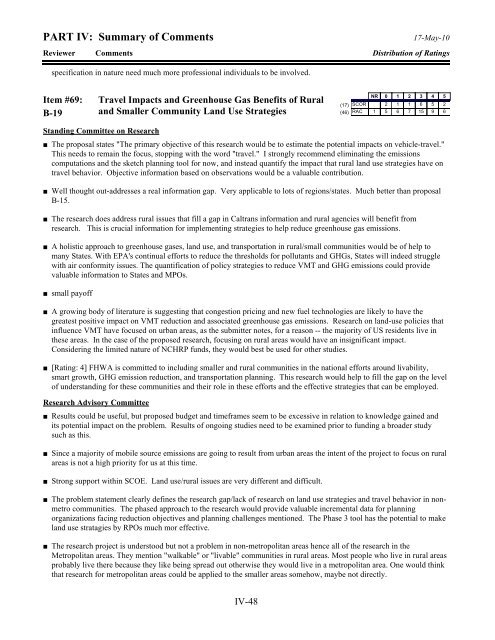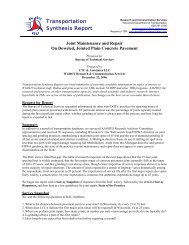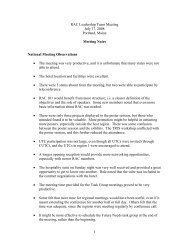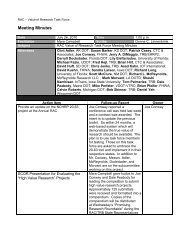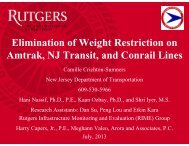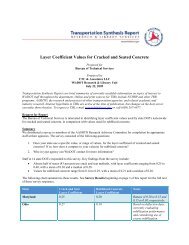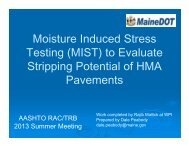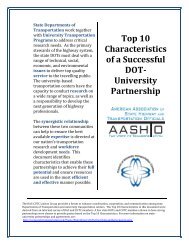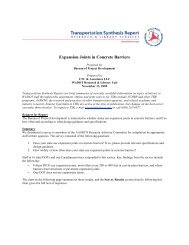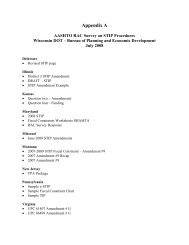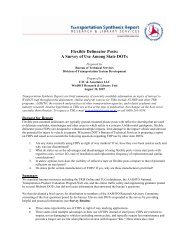PART IV: Summary of Comments - SCOR/RAC
PART IV: Summary of Comments - SCOR/RAC
PART IV: Summary of Comments - SCOR/RAC
Create successful ePaper yourself
Turn your PDF publications into a flip-book with our unique Google optimized e-Paper software.
<strong>PART</strong> <strong>IV</strong>: <strong>Summary</strong> <strong>of</strong> <strong>Comments</strong>17-May-10Reviewer <strong>Comments</strong> Distribution <strong>of</strong> Ratingsspecification in nature need much more pr<strong>of</strong>essional individuals to be involved.Item #69:B-19Travel Impacts and Greenhouse Gas Benefits <strong>of</strong> Ruraland Smaller Community Land Use Strategies(17)(46)NR 0 1 2 3 4 5<strong>SCOR</strong> 2 1 1 6 5 2<strong>RAC</strong> 1 5 6 7 15 9 6Standing Committee on Research■ The proposal states "The primary objective <strong>of</strong> this research would be to estimate the potential impacts on vehicle-travel."This needs to remain the focus, stopping with the word "travel." I strongly recommend eliminating the emissionscomputations and the sketch planning tool for now, and instead quantify the impact that rural land use strategies have ontravel behavior. Objective information based on observations would be a valuable contribution.■ Well thought out-addresses a real information gap. Very applicable to lots <strong>of</strong> regions/states. Much better than proposalB-15.■ The research does address rural issues that fill a gap in Caltrans information and rural agencies will benefit fromresearch.This is crucial information for implementing strategies to help reduce greenhouse gas emissions.■ A holistic approach to greenhouse gases, land use, and transportation in rural/small communities would be <strong>of</strong> help tomany States. With EPA's continual efforts to reduce the thresholds for pollutants and GHGs, States will indeed strugglewith air conformity issues. The quantification <strong>of</strong> policy strategies to reduce VMT and GHG emissions could providevaluable information to States and MPOs.■ small pay<strong>of</strong>f■ A growing body <strong>of</strong> literature is suggesting that congestion pricing and new fuel technologies are likely to have thegreatest positive impact on VMT reduction and associated greenhouse gas emissions. Research on land-use policies thatinfluence VMT have focused on urban areas, as the submitter notes, for a reason -- the majority <strong>of</strong> US residents live inthese areas. In the case <strong>of</strong> the proposed research, focusing on rural areas would have an insignificant impact.Considering the limited nature <strong>of</strong> NCHRP funds, they would best be used for other studies.■ [Rating: 4] FHWA is committed to including smaller and rural communities in the national efforts around livability,smart growth, GHG emission reduction, and transportation planning. This research would help to fill the gap on the level<strong>of</strong> understanding for these communities and their role in these efforts and the effective strategies that can be employed.Research Advisory Committee■ Results could be useful, but proposed budget and timeframes seem to be excessive in relation to knowledge gained andits potential impact on the problem. Results <strong>of</strong> ongoing studies need to be examined prior to funding a broader studysuch as this.■ Since a majority <strong>of</strong> mobile source emissions are going to result from urban areas the intent <strong>of</strong> the project to focus on ruralareas is not a high priority for us at this time.■ Strong support within SCOE. Land use/rural issues are very different and difficult.■ The problem statement clearly defines the research gap/lack <strong>of</strong> research on land use strategies and travel behavior in nonmetrocommunities. The phased approach to the research would provide valuable incremental data for planningorganizations facing reduction objectives and planning challenges mentioned. The Phase 3 tool has the potential to makeland use stratagies by RPOs much mor effective.■ The research project is understood but not a problem in non-metropolitan areas hence all <strong>of</strong> the research in theMetropolitan areas. They mention "walkable" or "livable" communities in rural areas. Most people who live in rural areasprobably live there because they like being spread out otherwise they would live in a metropolitan area. One would thinkthat research for metropolitan areas could be applied to the smaller areas somehow, maybe not directly.<strong>IV</strong>-48


